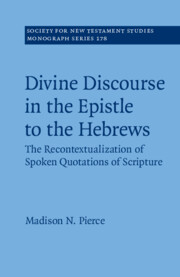Refine search
Actions for selected content:
19 results
3 - Christology in the New Testament: Epistles and Revelation
- from Part I - The Christological Sources
-
-
- Book:
- The Cambridge Companion to Christology
- Published online:
- 15 September 2025
- Print publication:
- 02 October 2025, pp 45-59
-
- Chapter
- Export citation
Introduction
-
- Book:
- Aelius Aristides and the Poetics of Lyric in Imperial Greek Culture
- Published online:
- 01 May 2025
- Print publication:
- 15 May 2025, pp 1-22
-
- Chapter
- Export citation
Chapter 28 - Editing Dictionaries
- from Part V - The Business of Dictionaries
-
-
- Book:
- The Cambridge Handbook of the Dictionary
- Published online:
- 19 October 2024
- Print publication:
- 31 October 2024, pp 562-592
-
- Chapter
- Export citation
Chapter 8 - Dictionaries of Quotations and Dictionaries of Proverbs
- from Part I - Types of Dictionaries
-
-
- Book:
- The Cambridge Handbook of the Dictionary
- Published online:
- 19 October 2024
- Print publication:
- 31 October 2024, pp 152-170
-
- Chapter
- Export citation
QUOTATIONS OF LUCAN AND THE INDIRECT TRADITION: TEXTUAL NOTES ON THE BELLVM CIVILE
-
- Journal:
- The Classical Quarterly / Volume 74 / Issue 1 / May 2024
- Published online by Cambridge University Press:
- 27 August 2024, pp. 185-195
- Print publication:
- May 2024
-
- Article
- Export citation
Chapter 25 - Lowell’s Influence
- from Part VI - Reputation and New Contexts
-
-
- Book:
- Robert Lowell In Context
- Published online:
- 28 March 2024
- Print publication:
- 04 April 2024, pp 272-283
-
- Chapter
- Export citation
Chapter 27 - Nonius Marcellus and the Shape of ‘Early Latin’
- from Part IV - Reception
-
-
- Book:
- Early Latin
- Published online:
- 27 July 2023
- Print publication:
- 17 August 2023, pp 549-562
-
- Chapter
- Export citation
From Naming Verb to Copula: The Case of Wangerooge Frisian Heit
-
- Journal:
- Journal of Germanic Linguistics / Volume 35 / Issue 2 / June 2023
- Published online by Cambridge University Press:
- 11 May 2023, pp. 97-147
-
- Article
-
- You have access
- Open access
- HTML
- Export citation
Chapter 8 - Style and presentation
- from Part II - Putting ideas to work
-
- Book:
- Keys to Academic English
- Published online:
- 17 April 2023
- Print publication:
- 11 April 2023, pp 336-385
-
- Chapter
- Export citation
Chapter 11 - Recording the Most Proper and Significant Words
- from Eighteenth-Century English Dictionaries: Prescriptivism and Completeness
-
-
- Book:
- The Cambridge Companion to English Dictionaries
- Published online:
- 18 September 2020
- Print publication:
- 24 September 2020, pp 129-141
-
- Chapter
- Export citation

Divine Discourse in the Epistle to the Hebrews
- The Recontextualization of Spoken Quotations of Scripture
-
- Published online:
- 14 August 2020
- Print publication:
- 23 July 2020
4 - Extra-Divine Discourse
-
- Book:
- Divine Discourse in the Epistle to the Hebrews
- Published online:
- 14 August 2020
- Print publication:
- 23 July 2020, pp 135-174
-
- Chapter
- Export citation
6 - Conclusion
-
- Book:
- Divine Discourse in the Epistle to the Hebrews
- Published online:
- 14 August 2020
- Print publication:
- 23 July 2020, pp 200-211
-
- Chapter
- Export citation
1 - The Author’s Exegetical Method and Speech in Hebrews
-
- Book:
- Divine Discourse in the Epistle to the Hebrews
- Published online:
- 14 August 2020
- Print publication:
- 23 July 2020, pp 1-34
-
- Chapter
- Export citation
5 - Divine Discourse and the Structure of Hebrews
-
- Book:
- Divine Discourse in the Epistle to the Hebrews
- Published online:
- 14 August 2020
- Print publication:
- 23 July 2020, pp 175-199
-
- Chapter
- Export citation
2 - Intra-Divine Discourse (1)
-
- Book:
- Divine Discourse in the Epistle to the Hebrews
- Published online:
- 14 August 2020
- Print publication:
- 23 July 2020, pp 35-90
-
- Chapter
- Export citation
Part XXIV - Shakespeare and the Book
-
-
- Book:
- The Cambridge Guide to the Worlds of Shakespeare
- Published online:
- 17 August 2019
- Print publication:
- 21 January 2016, pp 1661-1728
-
- Chapter
- Export citation
239 - Shakespeare in Quotations in Japanese
- from Part XXIV - Shakespeare and the Book
-
-
- Book:
- The Cambridge Guide to the Worlds of Shakespeare
- Published online:
- 17 August 2019
- Print publication:
- 21 January 2016, pp 1704-1706
-
- Chapter
- Export citation
236 - Shakespeare in Quotations in Spanish
- from Part XXIV - Shakespeare and the Book
-
-
- Book:
- The Cambridge Guide to the Worlds of Shakespeare
- Published online:
- 17 August 2019
- Print publication:
- 21 January 2016, pp 1698-1700
-
- Chapter
- Export citation
